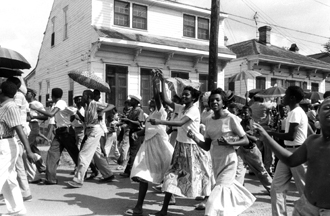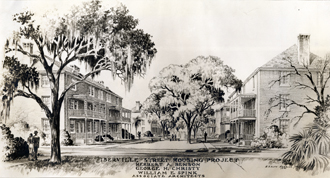Historic Treme Is Subject of Exhibit
Beginning in the 1930s, artist Ralston Crawford made several trips to New Orleans to photograph its vibrant African American culture. A number of his images depicting life in one of the city's most historic neighborhoods provides a lively visual centerpiece for “Tremé: People and Places,” an exhibition now on view at the Tulane Southeastern Architectural Archive.

The vibrant culture of the neighborhood is captured in this photo, “Tremé Second Line on North Derbigny,” 1958. (Ralston Crawford Collection, Hogan Jazz Archive)
Developed on a tract of land purchased by the city from property owner by Claude Tremé in 1810, the neighborhood that eventually flourished is considered to have comprised the largest community of free black and Creole people in the antebellum South. It's one that also reflects a large cultural diversity, says Keli Rylance, head of the archives and a curator of the exhibition.
“It's been a very rich mixed neighborhood since its founding,” says Rylance. “It included immigrants from China, Spain, France, Italy, Greece, as well Africans and transplants from Caribbean island nations. It continues to be a complex and multilayered place.”
It's also a neighborhood that has maintained its integrity despite forces of urban renewal, including the demolition of the famed Storyville red light district, widespread demolition associated with the development of public housing complexes, Louis Armstrong Park and the raised I-10 freeway.

Another facet of Treme history is shown in this drawing, “Iberville Housing Project, 1939-40,” Herbert A. Benson, George H. Christy, and William E. Spink. (Benson & Riehl Collection, Southeastern Architectural Archive.)
Along with photographs the exhibit features architectural drawings, city directories, cartographic documents, fire insurance plans and property assessments. “These documents suggest urban growth dynamics, as well as historical notions regarding class and national identity,” says Rylance.
It can take up to a year to put together an exhibit such as “Tremé: People and Places.” The effort is worth it, Rylance says, because it allows the archive to communicate to the public that it houses more than architectural records of grand buildings.
“We have material associated with more ordinary structures: laundromats, juke joints, fish shacks, landscaping, public market places.”
“Tremé: People and Places” will be on view through Nov. 4 in room 300 of Jones Hall on the uptown campus.
